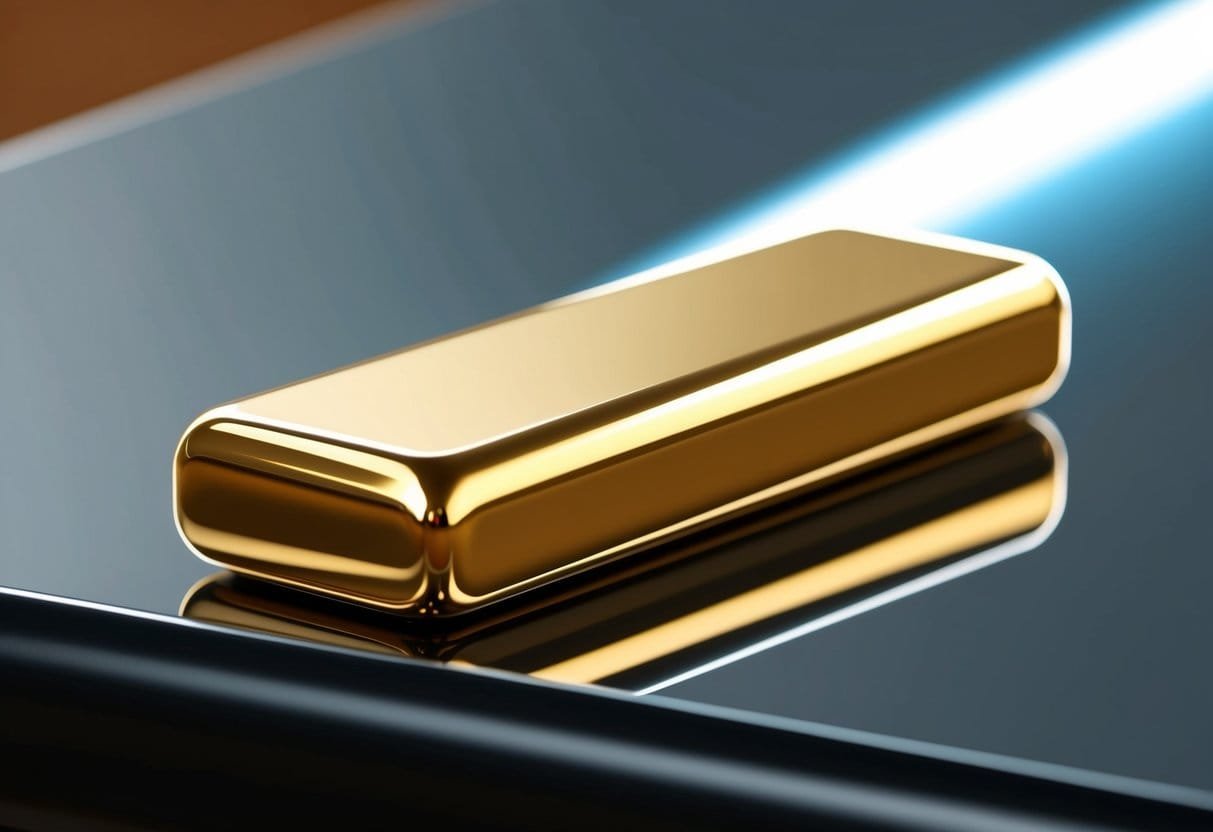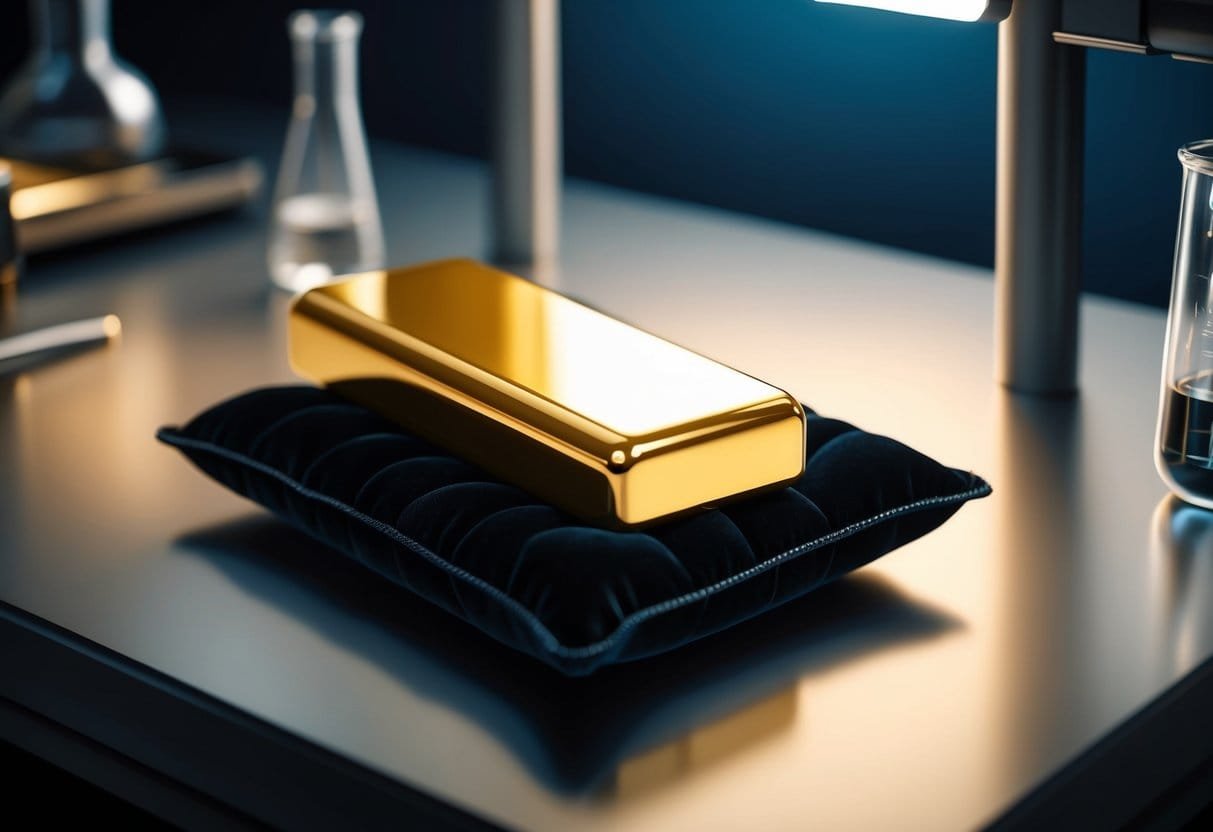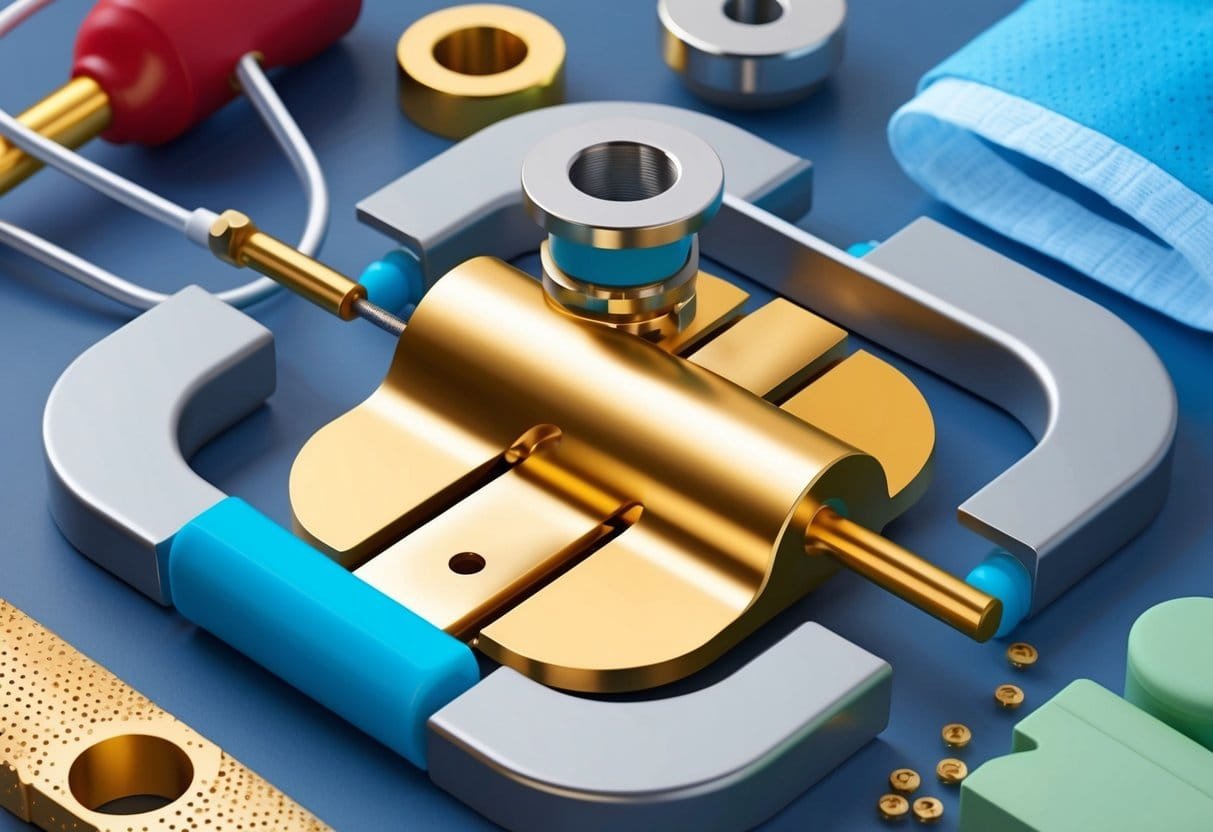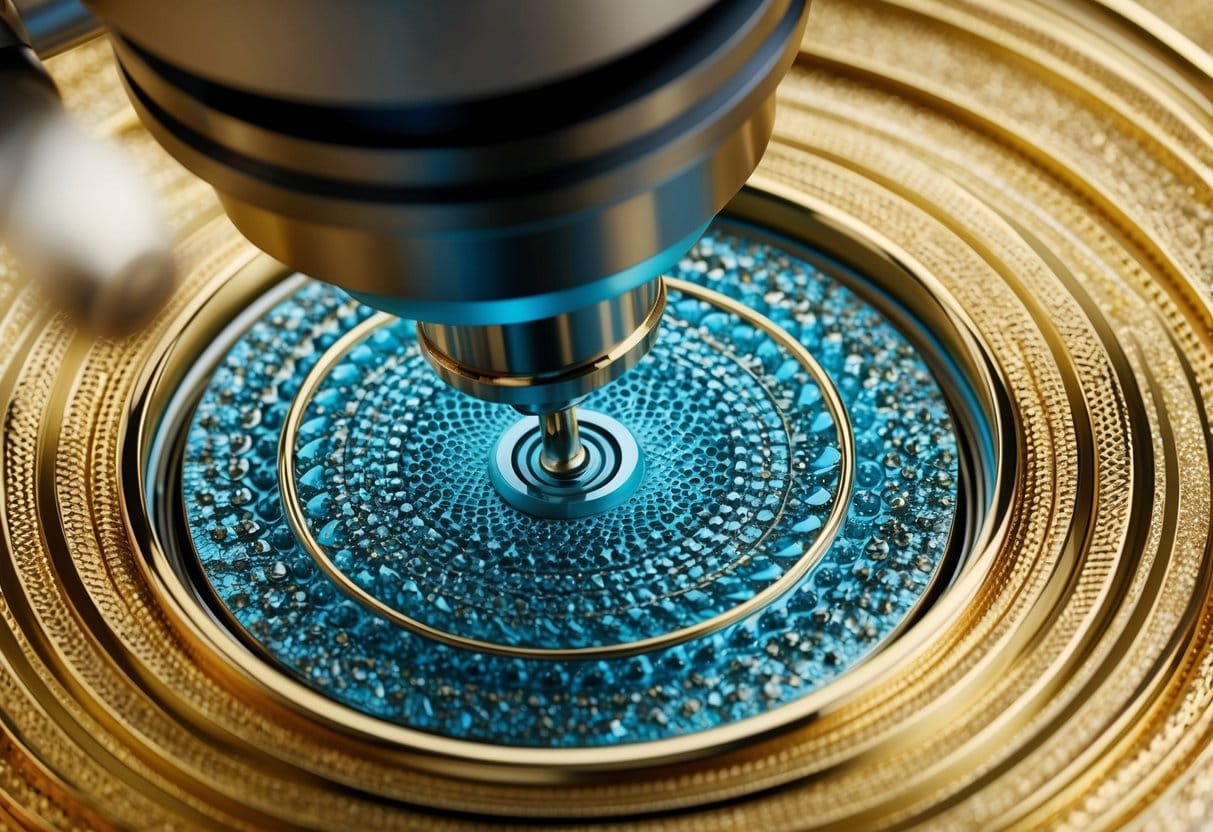Gold and titanium are both valuable metals with unique properties. When combined, they create an alloy that is stronger and more useful than either metal on its own.
Scientists at Rice University made an exciting discovery about gold-titanium alloys. They found that mixing 3 parts titanium with 1 part gold creates a super strong material. This gold-titanium alloy is up to 4 times harder than most steels and more biocompatible than pure titanium.
The special properties of this alloy make it very promising for many uses. It could be great for making long-lasting medical implants that are safe for the body. The alloy might also work well for jewelry or industrial tools that need to be both strong and resist wear over time.
Composition of Gold Titanium Alloy

Gold titanium alloys combine two valuable metals to create a unique material. These alloys have a specific atomic structure that gives them special properties.
Intermetallic Compounds
Gold titanium alloys are intermetallic compounds. This means the gold and titanium atoms bond in a specific way. They form a crystal structure that’s different from either metal on its own.
The atoms line up in a regular pattern. This pattern gives the alloy its unique traits. It’s not just a mix of gold and titanium – it’s a whole new material.
Some gold titanium alloys have more gold, while others have more titanium. The ratio changes how the atoms fit together. This affects the alloy’s strength and other qualities.
The Role of Ti-Au
Ti-Au is the chemical shorthand for titanium-gold compounds. These play a big part in the alloy’s behavior. Ti-Au compounds can be very hard, even harder than many steels!
One popular mix is titanium-3 gold. It has 3 parts titanium for every 1 part gold. This combo is super strong and tough.
Ti-Au compounds are useful in many fields. Dentists use them for strong, long-lasting tooth repairs. Jewelers like them because they’re pretty and durable. Even engineers find them handy for tough jobs.
The special bond between titanium and gold atoms makes these alloys special. It’s a team effort – neither metal could do it alone!
Properties of Gold Titanium Alloys

Gold titanium alloys have some surprising qualities. These mixtures of gold and titanium create materials with unique traits that make them useful in many fields.
Hardness and Strength
Gold titanium alloys are much harder than you might expect. A mix of 3 parts titanium to 1 part gold is four times harder than most steels. This alloy is called Ti3Au or Titanium-3.
The hardness comes from how the atoms line up. They form a special pattern that makes the metal really tough. This means it can stand up to a lot of wear and tear.
These alloys are also very strong. They can handle more stress before breaking than pure gold or titanium alone. This combo of hardness and strength makes them great for things that need to last a long time.
High Temperature Resilience
Gold titanium alloys can take the heat. They stay strong even when things get really hot. This is super helpful in places like jet engines or spacecraft.
At high temperatures, many metals get soft and weak. But gold titanium alloys keep their shape and strength. This lets them work in very hot spots where other metals would fail.
The mix of gold and titanium creates a material that doesn’t melt easily. It can handle extreme heat without losing its good qualities. This makes it perfect for tough jobs in hot places.
Magnetic Characteristics
Gold titanium alloys have some cool magnetic tricks. They can be more magnetic than either gold or titanium by itself. This is pretty neat because pure gold and titanium aren’t very magnetic on their own.
The way the gold and titanium atoms mix changes how electrons move around. This can make the alloy respond to magnets in new ways. Some mixtures might be great for making things like sensors or data storage.
Scientists are still learning about these magnetic properties. They might find new uses for gold titanium alloys in electronics or medical devices. It’s an exciting area of study with lots to discover.
Biocompatibility and Medical Application

Gold titanium alloys are great for use in the body. They don’t cause bad reactions and can last a long time. These alloys are used in many medical devices that go inside people.
Medical Implants and Applications
Gold titanium alloys are used in many medical implants. These include dental implants, which replace missing teeth. The alloys are strong and don’t rust in the mouth.
They’re also used in replacement joints. Hip joints made with gold titanium alloys can help people walk better. The alloys are light but tough, so they work well in the body.
Researchers like these alloys because they’re safe to use. The body doesn’t reject them, which is really important. This means fewer problems for patients after surgery.
Biomedical Implants
Gold titanium alloys shine in biomedical implants. They mix well with bone, helping implants stay in place. This is called osseointegration.
These alloys are also used in heart valves and pacemakers. They don’t cause allergies or infections, which is crucial for these devices. The alloys can be shaped into thin wires or plates as needed.
Doctors and patients like gold titanium implants. They’re strong, light, and safe. The body accepts them well, leading to faster healing. This makes them a top choice for many medical uses.
Manufacturing and Engineering Insights

Gold titanium alloys have changed the game in engineering materials. These innovative composites offer unique properties that open up new possibilities in various industries. Chemical dopants play a key role in enhancing their performance, while specialized production techniques ensure high-quality results.
Impact on Engineering Materials
Gold titanium alloys are shaking things up in the world of engineering. These materials are up to 4 times harder than steel, making them super tough. Engineers love them for their strength and light weight.
In aerospace, these alloys help build lighter planes that use less fuel. Medical implants benefit too – the alloys are strong and don’t react with the body. They’re also great for energy infrastructure, lasting longer in harsh conditions.
But it’s not all smooth sailing. Making these alloys can be tricky and expensive. Engineers are always looking for ways to make the process easier and cheaper.
Influence of Chemical Dopants
Chemical dopants are like secret ingredients that make gold titanium alloys even better. They change how the atoms line up, giving the alloy new superpowers.
Some dopants make the alloy stronger, while others help it resist wear and tear. For example, adding a bit of nickel can make the alloy tougher at high temperatures. This is great for jet engines!
Scientists are always trying new dopants to see what happens. Sometimes they find surprising results, like alloys that are both strong and flexible. It’s like a fun science experiment, but with real-world benefits.
Production Techniques
Making gold titanium alloys is a bit like baking a very fancy cake. The ingredients and method matter a lot.
One common technique is called powder metallurgy. It involves mixing tiny powders of gold and titanium, then heating them up until they stick together. This method allows for precise control over the alloy’s properties.
Another approach is melting the metals together. This can be tricky because gold and titanium have different melting points. Special furnaces help solve this problem.
Heat treatment is also super important. By carefully heating and cooling the alloy, engineers can make it stronger or more flexible. It’s like giving the metal a spa day to bring out its best qualities!
Scientific Research and Discoveries
Scientists have made exciting breakthroughs with gold-titanium alloys. Their findings reveal impressive strength and potential medical uses for these materials.
Contributions from Rice University
Rice University played a key role in gold-titanium alloy research. A team led by physicist Emilia Morosan made an unexpected discovery while studying the alloy.
They found a 3-to-1 mix of titanium and gold created an incredibly hard substance. This new alloy is about 3-4 times harder than most steels.
The researchers published their work in the journal Science Advances. Their findings opened up new possibilities for using these alloys in medicine.
Key Physical Research Findings
The gold-titanium alloy showed amazing physical properties. It’s strong, wear-resistant, and safe for use in the human body.
These qualities make it ideal for medical implants like artificial joints. The alloy could last longer than current titanium implants.
Eteri Svanidze and other researchers tested the material’s biocompatibility. They found it to be the hardest known metallic substance that’s safe for living tissues.
The team also discovered the alloy becomes even harder when cooled. This unique property could lead to more uses in various fields.
Advantages Over Other Materials

Gold titanium alloys offer some big benefits compared to other common materials. They combine the best traits of both metals to create something really special and useful.
Comparison with Steels
Gold titanium alloys shine when put up against steels. They’re much lighter but just as strong. This makes them great for things that need to be tough but not heavy.
These alloys don’t rust like steel does. They stay shiny and strong even in salty air or water. This is why they’re used a lot in boats and airplanes.
Gold titanium is also harder than many steels. It doesn’t get scratched or dented as easily. This means things made with it last longer and look better over time.
The alloy is also more flexible than steel. It can bend without breaking. This is really helpful in things like springs or medical implants.
Benefit Over Ceramics and Other Alloys
When compared to ceramics, gold titanium alloys have some clear wins. They’re not as brittle, so they don’t crack or shatter easily. This makes them safer in many uses.
These alloys can also be shaped and formed more easily than ceramics. This lets designers create more complex shapes and products.
Gold titanium beats many other alloys in wear resistance. It doesn’t grind down as fast when rubbed against other materials. This is great for machine parts that need to last a long time.
The alloy also conducts heat better than many ceramics. This helps in things like heat exchangers or cooking tools.
Lastly, gold titanium looks nicer than most ceramics or alloys. It keeps its shine and doesn’t tarnish easily. This makes it popular for jewelry and fancy watches.
Specialized Industrial Applications
Gold titanium alloys have found their way into high-tech industries due to their unique properties. These alloys offer exceptional strength, durability, and biocompatibility in specialized applications.
Aerospace and Defense Utility
In aerospace, gold titanium alloys excel in high-performance machinery. They’re used in turbine engines and other critical components where extreme conditions are the norm. The alloys’ high strength-to-weight ratio makes them ideal for aircraft parts that need to be both light and tough.
For defense applications, these alloys shine in armor plating. Their hardness, which can be up to 4 times that of steel, provides excellent protection against projectiles. This makes them valuable in military vehicle armor and personal protective equipment.
The wear resistance of gold titanium alloys is also prized in aerospace. This property helps extend the lifespan of crucial parts in engines and other systems, reducing maintenance needs and improving reliability.
Dentistry and Orthopedics
Gold titanium alloys have revolutionized dental implants and prosthetics. Their biocompatibility means the body is less likely to reject them, reducing complications for patients. The alloys’ strength allows for smaller, more natural-looking dental work.
In orthopedics, these alloys are used in joint replacements and bone plates. Their durability ensures long-lasting performance in the body. The alloys can be precisely engineered to match the mechanical properties of bone, improving patient comfort.
Dentists appreciate the corrosion resistance of gold titanium alloys. This quality helps maintain the integrity of dental work over time, even in the harsh environment of the mouth. It also contributes to better oral health by reducing the risk of metal ions leaching into the body.
Physical Structure Analysis

Gold-titanium alloys have a unique atomic structure that gives them special qualities. Their physical makeup affects how strong and useful they are.
Crystalline Form Assessment
Gold-titanium alloys can take different crystal shapes. The most common form is beta titanium, which has a cubic structure. This shape allows the atoms to pack tightly together.
Scientists use x-rays to see the crystal structure. The x-rays bounce off the atoms in a pattern. This pattern shows how the atoms are arranged.
The beta form is special because it’s stable at room temperature. This makes the alloy easier to work with and shape.
Atomic Arrangement Insights
In gold-titanium alloys, the atoms line up in a specific way. The gold atoms fit into spaces between the titanium atoms. This creates a strong bond between them.
The best mix seems to be 3 parts titanium to 1 part gold. This ratio makes an alloy that is four times harder than most steels.
The way the atoms fit together also affects other traits. For example, these alloys are often nonmagnetic. This can be useful in some medical devices.
By changing how the atoms are arranged, scientists can make the alloy stronger or more flexible. This helps them create materials for different uses.
Cultural and Artistic Importance

Gold titanium alloy has found its way into jewelry and artistic designs. This unique metal blend offers both beauty and durability, making it a favorite among artists and jewelry makers.
Gold Titanium in Jewelry
Gold titanium jewelry is becoming more popular. It combines the rich look of gold with the strength of titanium. This mix creates pieces that are both pretty and long-lasting.
Jewelers love using this alloy. It’s great for making rings, necklaces, and earrings. The alloy is harder than most steels, so it doesn’t scratch easily. This means your jewelry stays shiny for a long time.
Gold titanium jewelry comes in different colors. The amount of gold used changes the color. More gold makes it yellower, while more titanium makes it grayer. This range lets designers create unique looks.
Creative Expression and Design
Artists are finding new ways to use gold titanium alloy. Its strength and beauty open up lots of design options. Sculptors can make large pieces that are light but strong.
The alloy’s hardness lets artists create very detailed work. They can carve fine lines and textures that last. This is great for both small and big art pieces.
Some artists mix gold titanium with other materials. They might add gemstones or other metals. This creates eye-catching contrasts in color and texture. The alloy’s durability means these mixed-media works can last for years.
Gold titanium is also used in high-end products. You might see it in fancy watches or even in some electronics. Its mix of looks and toughness makes it perfect for items that need to be both pretty and strong.
Market Trends and Commercial Impact
The titanium alloy market is growing fast. Experts predict it will expand by 6.5% each year until 2029. That’s pretty exciting for the industry!
Airlines are using more titanium alloys in their planes. This is helping the market grow. As more people travel, airlines need more planes. This means more demand for titanium alloys.
The defense industry loves titanium alloys too. Countries are spending more on new military equipment. This is good news for titanium alloy makers.
Here are some key uses for titanium alloys:
- Airplane parts
- Military vehicles
- Medical implants
- Sports equipment
The market was worth $4.3 billion in 2021. It might reach $8.4 billion by 2029. That’s almost double!
Titanium alloys are replacing steel and aluminum in many products. They’re lighter and stronger. This makes them perfect for things that need to be tough but not heavy.
The biggest challenge? Titanium alloys can be expensive to make. But as technology improves, prices might come down. This could open up even more uses for these amazing materials.

